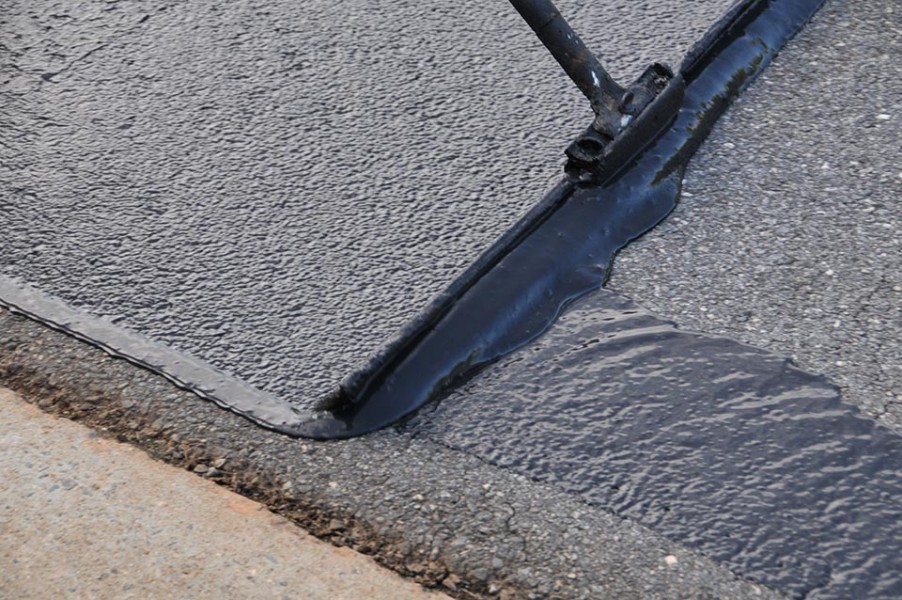Effective Asphalt Repair: Cold Mix Sealing Techniques Revealed
Effective Asphalt Repair: Cold Mix Sealing Techniques Revealed
Blog Article
Cold Mix Asphalt Vs. Hot Mix Asphalt: Which Is Right for You?

Structure Differences
Cold mix and warm mix asphalts differ considerably in their structure, with unique features that impact their efficiency and applications. Cold mix asphalt is produced by emulsifying the asphalt binder with water and an emulsifying representative prior to blending it with aggregate. This approach enables for the asphalt to be convenient at lower temperature levels, making it perfect for momentary repair services and for use in chillier weather condition conditions. Hot mix asphalt, on the other hand, is made at heats, commonly between 300-350 ° F, which aids to attain far better compaction and a more long lasting last item. The warm mix asphalt manufacturing procedure involves heating up the accumulation and asphalt binder separately before combining them at the asphalt plant.
Moreover, cold mix asphalt tends to be less thick and extra versatile than hot mix asphalt. This versatility makes it much better fit for locations with higher degrees of motion, such as driveways or roads with rush hour. In contrast, warm mix asphalt is known for its high sturdiness and resistance to rutting and cracking, making it a favored choice for freeways and high-traffic roads where longevity is critical.
Setup Process Variations
The procedure of mounting cool mix and hot mix asphalt displays significant variances in their treatments and needs. In comparison, hot mix asphalt necessitates a more fancy installment procedure. Due to the heating demands, warm mix asphalt installations are typically brought out by specialists with specialized devices, ensuring a more structurally sound and long-term result.
Longevity and Longevity Elements
When thinking about asphalt choices, sturdiness and longevity are crucial variables to evaluate for long lasting sidewalk efficiency. Hot mix asphalt (HMA) is recognized for its remarkable sturdiness and longevity.
In regards to longevity, HMA commonly exceeds CMA due to its premium stamina and resistance buildings. HMA sidewalks have a longer solution life, needing much less frequent fixings and maintenance, which can translate to set you back savings over time. Additionally, HMA pavements are extra conveniently adjustable to fulfill details task requirements, additionally enhancing their toughness.
Expense Factors To Consider
Considering the financial effects is a vital element when examining the option between warm mix asphalt (HMA) and chilly mix asphalt (CMA) for sidewalk jobs. While the first cost of warm mix asphalt is generally higher than that site that of cool mix asphalt, HMA usually provides a more affordable solution in the lengthy run due to its remarkable sturdiness and longevity.
In enhancement to material prices, it's important to take into consideration the costs linked with installation and upkeep when contrasting HMA and CMA. Inevitably, the decision in between HMA and CMA ought to take right into account not simply the preliminary price yet additionally the long-term monetary effects to identify the most affordable alternative for the particular sidewalk task.
Environmental Impact Contrast
Comparison of the environmental influences between hot mix asphalt (HMA) and cold mix asphalt (CMA) reveals distinct differences in sustainability practices. HMA production requires high temperatures, leading to raised energy consumption and greenhouse gas emissions.
Furthermore, the use of CMA frequently includes reusing existing asphalt pavement, promoting source preservation and lowering the quantity of waste sent out to garbage dumps. This recycling aspect better enhances the sustainability of CMA contrasted to HMA. Generally, when thinking about the environmental effect, CMA arises as a more environmentally lasting option because of its lower energy needs, minimized exhausts, and the capacity for recycling existing products. By selecting CMA over HMA, roadway building jobs can contribute favorably to ecological conservation efforts.
Verdict
To conclude, the choice between cool mix asphalt (CMA) and warm mix asphalt (HMA) depends upon numerous elements such as structure, click for source installment process, resilience, durability, price, and environmental effect. asphalt repair. While CMA provides a affordable and fast option for minor repair work, HMA makes sure superior resilience and long life for rush hour areas. Consider these elements thoroughly to determine which sort of check this site out asphalt is the ideal selection for your paving needs

Thinking about the economic implications is a crucial facet when examining the selection between hot mix asphalt (HMA) and cool mix asphalt (CMA) for sidewalk projects. While the preliminary expense of warm mix asphalt is commonly greater than that of cool mix asphalt, HMA frequently supplies an extra cost-effective solution in the lengthy run due to its remarkable toughness and long life. angle parking.Comparison of the ecological influences in between warm mix asphalt (HMA) and cold mix asphalt (CMA) exposes distinct differences in sustainability practices.In final thought, the option between chilly mix asphalt (CMA) and warm mix asphalt (HMA) depends on numerous variables such as make-up, installment procedure, durability, longevity, cost, and environmental impact
Report this page